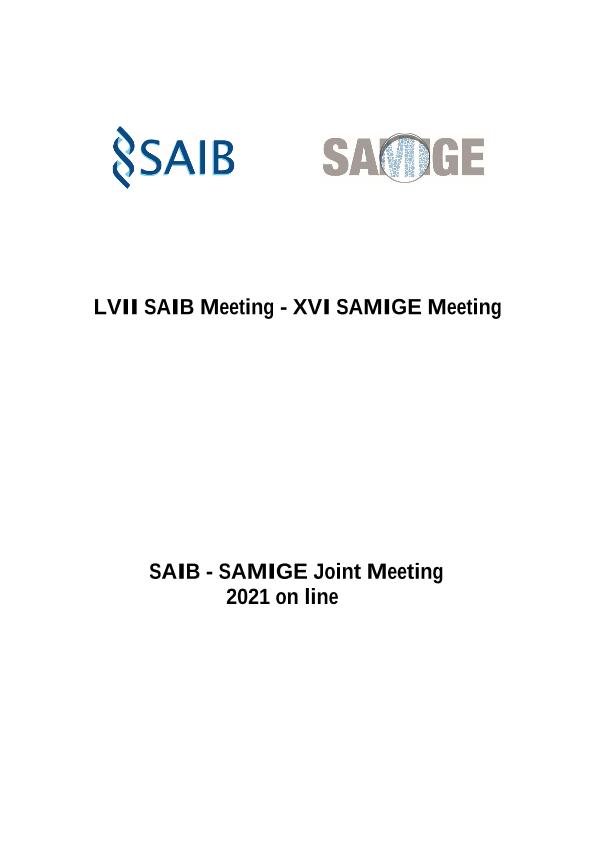Mostrar el registro sencillo del ítem
dc.contributor.author
Mlewski, Estela Cecilia

dc.contributor.author
Soto Rueda, Eliana
dc.contributor.author
Borgnino Bianchi, Laura Carolina

dc.date.available
2022-08-10T16:39:51Z
dc.date.issued
2021
dc.identifier.citation
Assessing the potential of Rivularia halophila for arsenic removal; LVII Annual Meeting of the Argentine Society for Biochemistry and Molecular Biology Research and XVI Annual Meeting of the Argentinean Society for General Microbiology; Virtual; Argentina; 2021; 40-41
dc.identifier.issn
0327-9545
dc.identifier.uri
http://hdl.handle.net/11336/165010
dc.description.abstract
Rivularia halophila (R. halophila) is a filamentous cyanobacteria isolated from microbial mats of the Laguna Negra Lake (LN), Catamarca, Puna-Argentina. The LN is a high-altitude hypersaline lake, where extreme environmental conditions (i.e., high UV-radiation and extreme temperature, salinity, and water activity) restrict eukaryotic life. Besides, the presence of arsenic (As) has been detected in water, sediments and lithified microbial mats. This particular cyanobacteria is part of a microbial consortium that participates actively in the carbonate precipitation process. Taking this into account, the objective of this study were (i) to evaluate the capability of R. halophila to tolerate moderate to high As concentration and (ii) to assess the role of this cyanobacteria in carbonate precipitation with the potential incorporation of As in the carbonate lattice. Tolerance and resistance experiments were perform under different As (III and V) concentration, and evaluated by biomass growth, pigment intensity and chlorophyll a content. Besides, lethal dose 50 (LD 50) was also evaluated. On the other hand, carbonate precipitation experiments were perform under different calcium concentrations and moderate levels of As (similar to LN concentrations). Optical and electronic microscopy images of the precipitates were taken and measured near the cyanobacterial sheaths and from the bottom of the culture flask. DRX analysis were also performed. Preliminary results showed that R. halophila tolerates high concentrations of As (III and V), especially As (V), and can accumulate As in the sheath and in the cells. Moreover, R. halophila might facilitate carbonate precipitation in culture. The precipitation of amorphous crystals, near the sheath, were observed with the addition of As (V); while without R. halophila the minerals were mostly geometric, corresponding to chemical precipitation. All the results obtained until now, give us some clues about the potential of this cyanobacteria for As bio-removal.
dc.format
application/pdf
dc.language.iso
eng
dc.publisher
Tech Science Press

dc.rights
info:eu-repo/semantics/openAccess
dc.rights.uri
https://creativecommons.org/licenses/by-nc-sa/2.5/ar/
dc.subject
ARSENIC
dc.subject
CYANOBACTERIA
dc.subject
BIO REMOVAL
dc.subject
CARBONATE
dc.subject.classification
Otras Ciencias de la Tierra y relacionadas con el Medio Ambiente

dc.subject.classification
Ciencias de la Tierra y relacionadas con el Medio Ambiente

dc.subject.classification
CIENCIAS NATURALES Y EXACTAS

dc.title
Assessing the potential of Rivularia halophila for arsenic removal
dc.type
info:eu-repo/semantics/publishedVersion
dc.type
info:eu-repo/semantics/conferenceObject
dc.type
info:ar-repo/semantics/documento de conferencia
dc.date.updated
2022-08-08T15:37:56Z
dc.journal.pagination
40-41
dc.journal.pais
Argentina

dc.journal.ciudad
Buenos Aires
dc.description.fil
Fil: Mlewski, Estela Cecilia. Consejo Nacional de Investigaciones Científicas y Técnicas. Centro Científico Tecnológico Conicet - Córdoba. Instituto Multidisciplinario de Biología Vegetal. Universidad Nacional de Córdoba. Facultad de Ciencias Exactas Físicas y Naturales. Instituto Multidisciplinario de Biología Vegetal; Argentina
dc.description.fil
Fil: Soto Rueda, Eliana. Consejo Nacional de Investigaciones Científicas y Técnicas. Centro Científico Tecnológico Conicet - Córdoba. Centro de Investigaciones en Ciencias de la Tierra. Universidad Nacional de Córdoba. Facultad de Ciencias Exactas Físicas y Naturales. Centro de Investigaciones en Ciencias de la Tierra; Argentina
dc.description.fil
Fil: Borgnino Bianchi, Laura Carolina. Consejo Nacional de Investigaciones Científicas y Técnicas. Centro Científico Tecnológico Conicet - Córdoba. Centro de Investigaciones en Ciencias de la Tierra. Universidad Nacional de Córdoba. Facultad de Ciencias Exactas Físicas y Naturales. Centro de Investigaciones en Ciencias de la Tierra; Argentina
dc.relation.alternativeid
info:eu-repo/semantics/altIdentifier/url/https://congresos.g2consultora.com/wp-content/uploads/2021/10/Biocell-Preprint-SAIB-SAMIGE-2021.pdf
dc.conicet.rol
Autor

dc.conicet.rol
Autor

dc.conicet.rol
Autor

dc.coverage
Internacional
dc.type.subtype
Reunión
dc.description.nombreEvento
LVII Annual Meeting of the Argentine Society for Biochemistry and Molecular Biology Research and XVI Annual Meeting of the Argentinean Society for General Microbiology
dc.date.evento
2021-11-01
dc.description.ciudadEvento
Virtual
dc.description.paisEvento
Argentina

dc.type.publicacion
Journal
dc.description.institucionOrganizadora
Sociedad Argentina de Investigación Bioquímica y Biología Molecular
dc.description.institucionOrganizadora
Asociación Civil de Microbiología General
dc.source.revista
Biocell

dc.date.eventoHasta
2021-11-05
dc.type
Reunión
Archivos asociados
